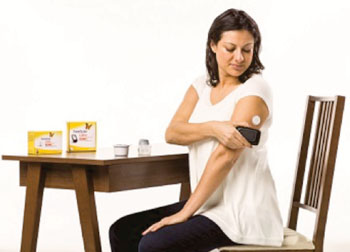Revolutionary Glucose Monitoring System Receives CE Marking
By HospiMedica International staff writers
Posted on 30 Sep 2014
A revolutionary new glucose sensing technology, which eliminates the need for routine finger pricks, has received Conformité Européenne (CE) marking.Posted on 30 Sep 2014
The system measures glucose levels through a sensor that can be worn on the back of the upper arm for up to 14 days and in addition, no finger prick calibration is needed, a key differentiator from current continuous glucose monitoring systems.

Image: The FreeStyle Libre Flash Glucose Monitoring System (Photo courtesy of Abbott Diabetes Care).
The FreeStyle Libre Flash Glucose Monitoring System (Abbott Diabetes Care; Alameda, CA, USA) consists of a small, round sensor worn on the back of the upper arm, which measures glucose every minute in interstitial fluid through a small, 5-mm long, 0.4-mm wide filament that is inserted just under the skin and held in place with a small adhesive pad. A reader is scanned over the sensor to get a glucose result painlessly in less than one second. Scanning can take place while the sensor is under clothing, making testing more discreet and convenient and each scan displays a real-time glucose result, a historical trend, and the direction the glucose is heading.
The reader holds up to 90 days of data, providing a historical snapshot of glucose levels over time. The FreeStyle Libre System software enables the data to be presented in a user-friendly, visual chart for both healthcare professionals and patients, driving a more productive discussion around treatment and any necessary modification. A recent study conducted by Abbott has shown that the FreeStyle Libre System is clinically proven to be accurate, stable and consistent over 14 days without the need for finger prick calibration. The FreeStyle Libre System provides users and their physicians with the Ambulatory Glucose Profile (AGP), a report providing a visual snapshot of a person′s typical day by utilizing dense glucose data revealing hypoglycemic and hyperglycemic trends to facilitate better patient therapy and education. The system will be available in seven countries across Europe in the coming weeks.
Clifford J. Bailey, PhD, FRCP, FRCPath, a professor of Clinical Science and Director of Biomedical Sciences Research at Aston University (Birmingham, UK), said, “For decades, people with diabetes have had to prick their fingers routinely to check their glucose levels. The pain and inconvenience of finger pricks has contributed to less frequent testing and suboptimal diabetes management. By eliminating the need for routine finger pricks, the FreeStyle Libre System will significantly advance the field of glucose monitoring. It offers a convenient and painless way to get more frequent glucose readings, which should help to improve diabetes management.” The study details were presented at the at the Abbott Symposium at the European Association for the Study of Diabetes (EASD) medical conference held September 15–19, 2014, in Vienna (Austria).
Related Links:
Abbott Diabetes Care
Aston University














